Contemporary Spanish cuisine is not just the result of Ferran Adrià’s technical lesson and of his avant-garde. In other words, it’s not just about acquiring and presenting the innovations from that period, which led to a new scientific approach to food, including notions from chemistry, physics, and procedures that were previously only applied to industry, and not just the food one. Contemporary Spanish cuisine was and still is about having a free view of reality, of the local territory and its history, later presenting this through food. It’s a general change of paradigm, an infinite impulse towards research and creativity, looking at the future while analysing the past: if this were not the case, one could not understand the work of the following generation of Spanish chefs, from Angel León to David Muñoz, just to name two among the most famous ones.
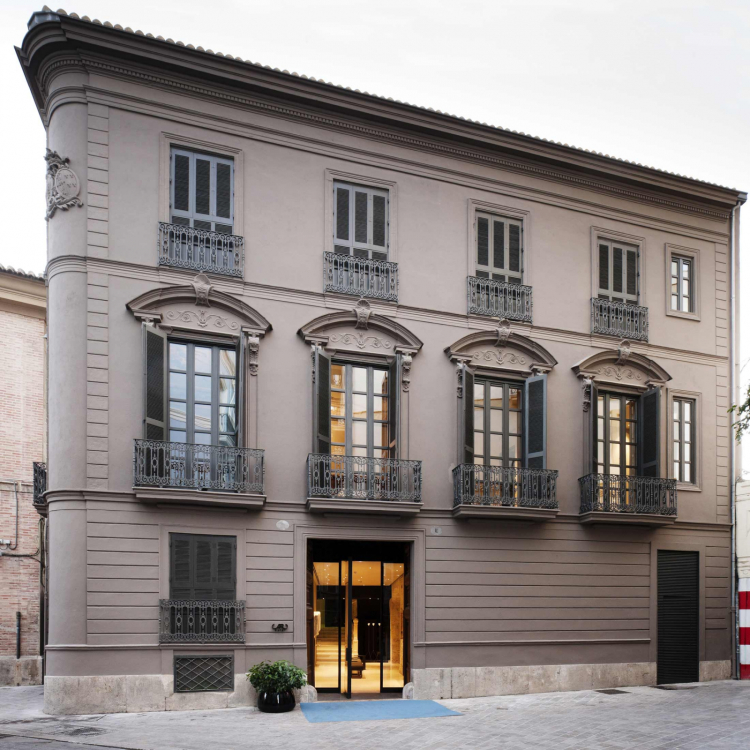
The 19th century façade of Caro Hotel

Inside, ancient remains from various eras
(Barcelona, 1984) is less known in Italy than the former two chefs (for now). Yet he quickly conquered a Michelin star, little over a year after opening – in March 2016 – his restaurant
Sucede, inside the beautiful
Caro Hotel in Valencia.
Mayor has experience with many of Spain’s greatest chefs, from
Ferran Adrià (2009-2011 at
elBulli, but he also worked with the
elBulliFoundation until 2015) and
Sergi Arola at
Arts in Barcelona (2011-2013, and before that with
Andoni Aduriz (2003) and
Quique Dacosta (2007). He ended up working in a very stimulating place, that is to say
Caro Hotel.
Palacio Marqués de Caro has a façade from the 19th century, but inside it has authentic elements from up to 2000 years ago, including a Roman mosaic from the 2nd Century, some 13th-Century remains from the Arab city walls and Gothic arches. The chef had a brilliant intuition: he was inspired by this special situation and started a thorough research on Pre-Columbian Valencian cuisine, that is to say of products, dishes and techniques from the Roman and Arab era, given they work surrounded by ruins from those times.
We mentioned a "thorough research": indeed the initial idea wasn’t just an input for a successful activity of culinary marketing, or for some isolated, relaxing research.
Mayor, on the contrary, started a constant collaboration with the local university, thus creating a real research group studying the history in terms of distant and often forgotten culinary traditions that still have a profound connection with the current culinary scene.
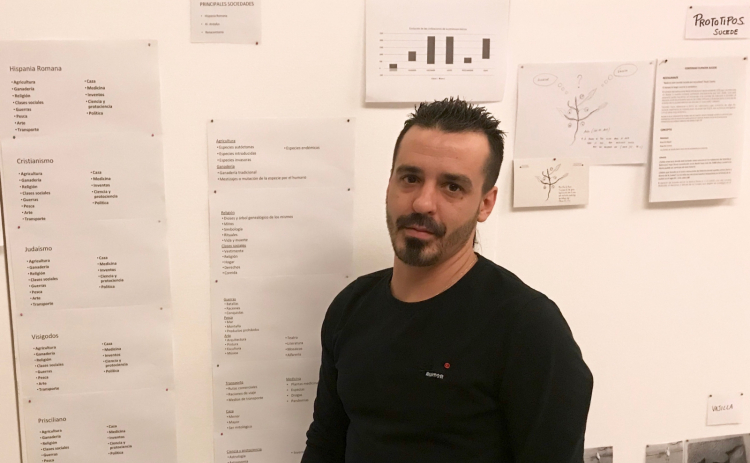
Miguel Ángel Mayor in the dining room dedicated to the research of ancient recipes. To his right, an outline of Pre-Columbian historic eras and their respective food features: Roman Hispania, Christianity, Judaism, the Visigoth period, the Priscillian era (named after Spanish heretic Priscillian, 340-385), up to the Al-andalus, that is to say the Arab Andalusia
The team, some twenty people, meets in a room close to the main dining room at
Sucede. While the latter features architectural elements from the past, especially perfectly renovated Arab walls, the former spaces are filled with diagrams, outlines, projects and reports. It’s a real scientific-cultural laboratory analysing the Roman and Arab food style. And it gives constant inspiration to the creativity of the chef who represents those flavours, though interpreted with a current approach and palate.
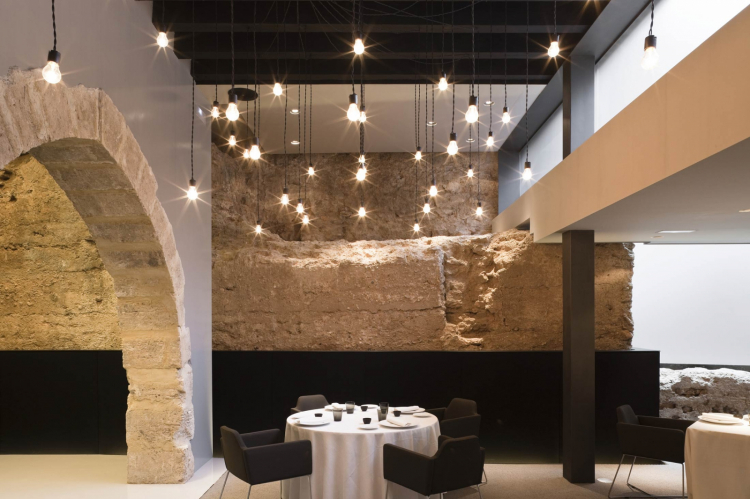
The dining room at Sucede with Arab walls and Gothic arches
, as a result of his professional training, is very focused on techniques. But technique for him is not important per se. He adds infinite elements thanks to the above-mentioned constant research (at
Sucede you dine close to a Latin
triclinium, «today, we eat in the same place where ancient Romans ate two thousand years ago»), and focuses on local raw materials – fully in line with current fine dining trends. He says: «Be it the base for a broth or a spherification, in both cases what’s important is that we use excellent products. We want to give value to the great local ingredients».
Jesús Terrés is a famous journalist, director of the
Guía Hedonista, the most important point of reference for local gastronomic criticism. He says: «Here in town they’ve been experimenting more and more on the so called
tercera via, a third way in between pure avant-garde creativity and a focus on products. For a Spanish gastronomist these days this is essential, contemporary thought: and the resulting model is particularly strong in Valencia.
Técnica y temporalidad».
Mayor, as we’ve seen, includes his personal creative project and research in this general trend. He analyses elements such as chickpea coffee («The coffee of the poor») and rosewater, mead and citrus fruits, and
chufa too –
tigernut in English – that is to say a sweet tuber from
Cyperus esculentus, which is the base for the most typical Valencian drink (first mentioned in documents from Ancient Egypt. A research from the University of Valencia discovered that in the tomb of an Egyptian high official there were illustrations that could mean that he couldn’t resist such delicacies as cakes made with
chufa, plus butter and honey. But some also believe that
chufa was already known and eaten by our ancestor the
Australopithecus boisei, over two million years ago). Our chef is supported by the work of researchers such as professor
Charo Marco, who lives in Segovia, an ancient Roman colony, some 30 km from Valencia.
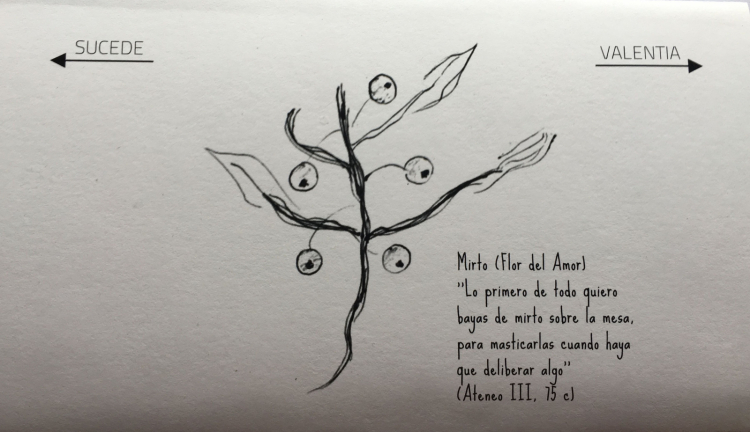
The two menus: Sucede and Valentia
This ferment results in
Sucede’s fantastic culinary offer. There are only two tasting menus available, a longer one for 90 euros called
Valentia and a shorter one,
Sucede, which is a selection of the former, for 70 euros. In both cases the offer is divided visually into two different parts: one with dishes inspired by Ancient Rome, the other with Arab inspired dishes. Of course, we chose the long menu, which you can see in the photo gallery.
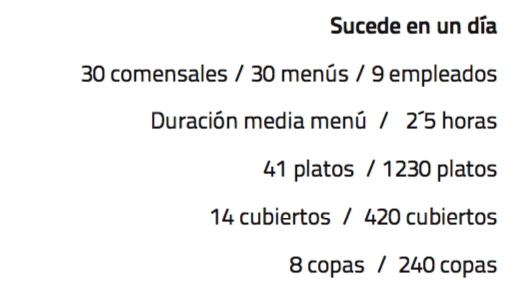
Some daily data at Sucede: 30 guests, as many menus, 9 members of staff in the dining room; the menu lasts 2.5 hours on average, 41 plates (therefore 1230 for 30 guests), 14 pieces of cutlery (420) and 8 glasses of wine (240)
Some notes. First: when we mention the long menu, it is very long: there are 38 dishes (respectively 21 and 17) in our cases, and up to 41 if available. Second: this is another reason why you have great fun. Not just because of the quality of the food, but because each dish, often divided into multiple tastings, implies a historic concept that
Mayor explains to the guest. So you taste
mulsum (a typical Latin drink made by mixing wine and honey) and a hollandaise sauce made with
garum (
garum is very difficult for our palates, as
Mayor tells us and
Pasquale Torrente who has also tried to recreate it can confirm); of crispy (and delicious) rabbit ears and
arnadì, an Arab-Valencian cake made with pumpkin and pine nuts.
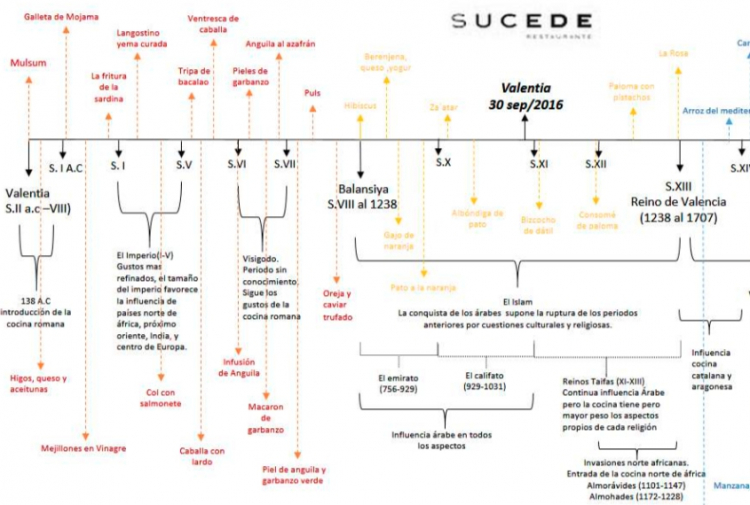
Part of a culinary-historic reconstruction of Valencia. «The structure of the Valentia follows the still current outline of a Roman banquet: first, they serve the entrées, which must stimulate the appetite; then, the main dishes, based on vegetables, cereals, eggs, legumes, meat and fish; finally, cakes and fruits as dessert. With independent variations and micromenum within the main offer, our fil rouge faithfully follows this historic approach»
Third and last:
Mayor is a great chef. His dishes are not the "victim" of a project he has set his mind on; on the contrary, they make use of the inspiration behind them so as to reach original harmonies with different combinations, often going beyond the sweet-savoury boundary and presenting unusual yet delicious elements. Overall, the tasting is a kaleidoscope of delicacies, double face: it’s delicious or it’s the result of an extraordinary, and delicious, research. As you wish.
«The goal of our tasting menus is honouring the local culinary memory with absolute creative freedom. Valentia, our larger tasting menu, is named after the Roman name of the city, as a tribute to our origins, and goes as far as Balansiya [the town’s name in Arab times]. We studied the foundations of both eras, we understood their culinary principles and we try to start from these so as to make space and time meet and embrace the cuisine of the 21st century» (Miguel Ángel Mayor)
Translated into English by Slawka G. Scarso
Sucede at Caro Hotel
Almirall 14, Valencia
Tel. +34 963 155 287
www.sucede.com
Open at lunchtime and in the evening, closed on Sunday and Monday
Tasting menus only, for 70 and 90 euros